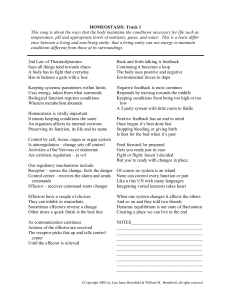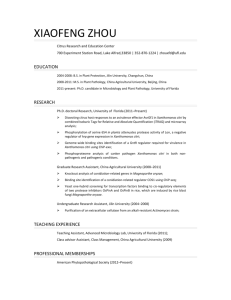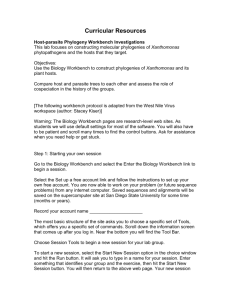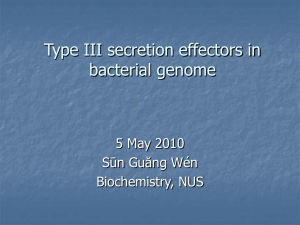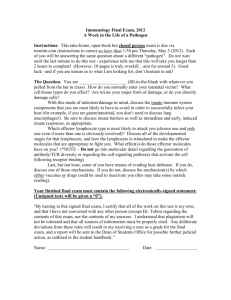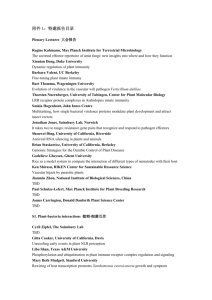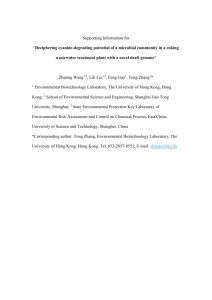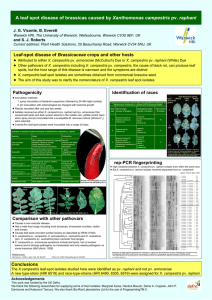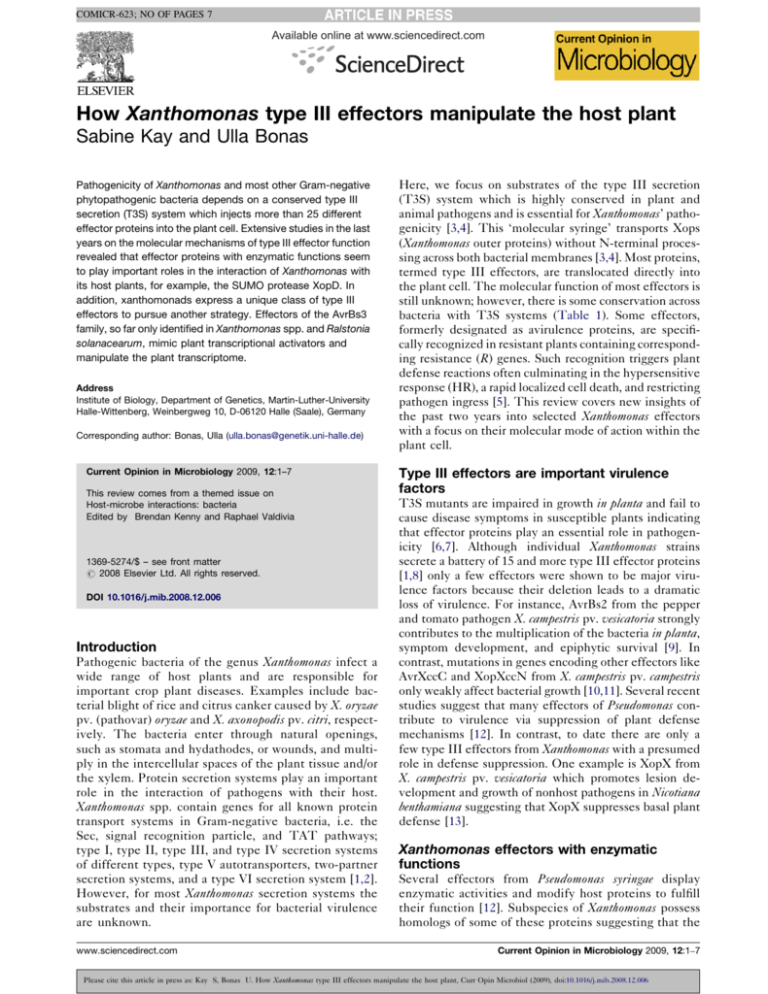
COMICR-623; NO OF PAGES 7
Available online at www.sciencedirect.com
How Xanthomonas type III effectors manipulate the host plant
Sabine Kay and Ulla Bonas
Pathogenicity of Xanthomonas and most other Gram-negative
phytopathogenic bacteria depends on a conserved type III
secretion (T3S) system which injects more than 25 different
effector proteins into the plant cell. Extensive studies in the last
years on the molecular mechanisms of type III effector function
revealed that effector proteins with enzymatic functions seem
to play important roles in the interaction of Xanthomonas with
its host plants, for example, the SUMO protease XopD. In
addition, xanthomonads express a unique class of type III
effectors to pursue another strategy. Effectors of the AvrBs3
family, so far only identified in Xanthomonas spp. and Ralstonia
solanacearum, mimic plant transcriptional activators and
manipulate the plant transcriptome.
Address
Institute of Biology, Department of Genetics, Martin-Luther-University
Halle-Wittenberg, Weinbergweg 10, D-06120 Halle (Saale), Germany
Corresponding author: Bonas, Ulla (ulla.bonas@genetik.uni-halle.de)
Current Opinion in Microbiology 2009, 12:1–7
This review comes from a themed issue on
Host-microbe interactions: bacteria
Edited by Brendan Kenny and Raphael Valdivia
1369-5274/$ – see front matter
# 2008 Elsevier Ltd. All rights reserved.
DOI 10.1016/j.mib.2008.12.006
Introduction
Pathogenic bacteria of the genus Xanthomonas infect a
wide range of host plants and are responsible for
important crop plant diseases. Examples include bacterial blight of rice and citrus canker caused by X. oryzae
pv. (pathovar) oryzae and X. axonopodis pv. citri, respectively. The bacteria enter through natural openings,
such as stomata and hydathodes, or wounds, and multiply in the intercellular spaces of the plant tissue and/or
the xylem. Protein secretion systems play an important
role in the interaction of pathogens with their host.
Xanthomonas spp. contain genes for all known protein
transport systems in Gram-negative bacteria, i.e. the
Sec, signal recognition particle, and TAT pathways;
type I, type II, type III, and type IV secretion systems
of different types, type V autotransporters, two-partner
secretion systems, and a type VI secretion system [1,2].
However, for most Xanthomonas secretion systems the
substrates and their importance for bacterial virulence
are unknown.
www.sciencedirect.com
Here, we focus on substrates of the type III secretion
(T3S) system which is highly conserved in plant and
animal pathogens and is essential for Xanthomonas’ pathogenicity [3,4]. This ‘molecular syringe’ transports Xops
(Xanthomonas outer proteins) without N-terminal processing across both bacterial membranes [3,4]. Most proteins,
termed type III effectors, are translocated directly into
the plant cell. The molecular function of most effectors is
still unknown; however, there is some conservation across
bacteria with T3S systems (Table 1). Some effectors,
formerly designated as avirulence proteins, are specifically recognized in resistant plants containing corresponding resistance (R) genes. Such recognition triggers plant
defense reactions often culminating in the hypersensitive
response (HR), a rapid localized cell death, and restricting
pathogen ingress [5]. This review covers new insights of
the past two years into selected Xanthomonas effectors
with a focus on their molecular mode of action within the
plant cell.
Type III effectors are important virulence
factors
T3S mutants are impaired in growth in planta and fail to
cause disease symptoms in susceptible plants indicating
that effector proteins play an essential role in pathogenicity [6,7]. Although individual Xanthomonas strains
secrete a battery of 15 and more type III effector proteins
[1,8] only a few effectors were shown to be major virulence factors because their deletion leads to a dramatic
loss of virulence. For instance, AvrBs2 from the pepper
and tomato pathogen X. campestris pv. vesicatoria strongly
contributes to the multiplication of the bacteria in planta,
symptom development, and epiphytic survival [9]. In
contrast, mutations in genes encoding other effectors like
AvrXccC and XopXccN from X. campestris pv. campestris
only weakly affect bacterial growth [10,11]. Several recent
studies suggest that many effectors of Pseudomonas contribute to virulence via suppression of plant defense
mechanisms [12]. In contrast, to date there are only a
few type III effectors from Xanthomonas with a presumed
role in defense suppression. One example is XopX from
X. campestris pv. vesicatoria which promotes lesion development and growth of nonhost pathogens in Nicotiana
benthamiana suggesting that XopX suppresses basal plant
defense [13].
Xanthomonas effectors with enzymatic
functions
Several effectors from Pseudomonas syringae display
enzymatic activities and modify host proteins to fulfill
their function [12]. Subspecies of Xanthomonas possess
homologs of some of these proteins suggesting that the
Current Opinion in Microbiology 2009, 12:1–7
Please cite this article in press as: Kay S, Bonas U. How Xanthomonas type III effectors manipulate the host plant, Curr Opin Microbiol (2009), doi:10.1016/j.mib.2008.12.006
COMICR-623; NO OF PAGES 7
2 Host-microbe interactions: bacteria
Table 1
Known type III effectors of Xanthomonas and their (putative) function
Protein(s)
AvrBs1
AvrBs2
AvrBs3, Avrb6, AvrXa7,
PthA, and others
AvrRxo1
AvrRxv, AvrBsT,
AvrXv4, XopJ
AvrXccC
AvrXv3
Ecf XopX
HpaA
XopB
XopC
XopD
XopE1, XopE2
XopF1, XopF2
XopN
XopO
XopP
XopQ
Homologsa in
(Predicted) function
Unknown function
Putative glycerophosphoryldiester phosphodiesterase
AvrBs3 family, TAL activity
Unknown function
YopJ/AvrRxv-family, putative
cysteine proteases (C55 family)
or acetyltransferases
AvrB family, unknown function
Unknown function
HopAE1 family, unknown function
Unknown function
Unknown function
Unknown function
SUMO cysteine protease
(C48 family), DNA-binding
(HLH motif), EAR motifs
HopX family, putative
transglutaminases
Unknown function
Unknown function
Unknown function
Unknown function
HopQ1-1 family, putative
inosine-uridine nucleoside
N-ribohydrolase
Xac
Xcc
Xcv
+
+
+
+
+
+
+
+
+
+
+
+
+
(+)
+
+
+
+
+
+
+
+
+
+
+
+
(+)
+
(+)
+
+
+
+
+
+
+
+
+
+
+
(+)
Xoc
Xoo
+
+
Ps
Rs
apb
+
+
+
+
+
+
+
+
+
+
+
[9,28,29,41]
+
[47]
[9,16]
(+)
[10]
[48]
[9]
[49]
[9]
[9]
[9,18]
+
[16]
+
+
+
+
+
+
[9]
[9]
+
+
+
+
+
Reference b
+
(+)
+
+
+
+
+
[9]
[9,11]
[9]
[9]
[9]
a
Homologs of effectors from X. campestris pv. vesicatoria and, in case of AvrXccC, X. campestris pv. campestris were identified using BLAST
algorithms [50]. (+) indicates partial homology or disrupted homologs. Xac, X. axonopodis pv. citri; Xcc, X. campestris pv. campestris; Xcv, X.
campestris pv. vesicatoria; Xoc, X. oryzae pv. oryzicola; Xoo, X. oryzae pv. oryzae; Ps, P. syringae; Rs, R. solanacearum; apb, Gram-negative animal–
pathogenic bacteria.
b
Xanthomonas effectors are reviewed in [9]. Additional results are cited separately.
effectors have similar activities. For instance, there are
putative effectors which show homology to HopAO1
(also known as HopPtoD2) from P. syringae that has
tyrosine phosphatase activity and suppresses basal
defense and the HR [14,15]. XopE1 and XopE2 belong
to the HopX (AvrPphE) family of putative transglutaminases [16] with a cysteine-based catalytic triad essential for function [17]. The transglutaminase superfamily
comprises proteins with different enzymatic activities
like proteases, peptide N-glycanases, and DNA repair
proteins [16]. However, an enzymatic activity has yet to
be shown for the Xanthomonas effectors, and their
putative virulence effects are unknown.
The SUMO protease XopD
XopD from X. campestris pv. vesicatoria has recently been
studied in detail. Interestingly, this effector promotes
bacterial growth in tomato and delays onset of leaf
chlorosis and necrosis in late infection stages of tomato,
presumably to sustain the bacterial population in the
infected tissue [18]. The XopD protein has a modular
structure and shows different biochemical activities
(Figure 1a). The C terminus contains a cysteine protease
Current Opinion in Microbiology 2009, 12:1–7
domain of the C48 superfamily with homology to yeast
Ulp1 (ubiquitin-like protease), a small ubiquitin-like
modifier (SUMO) protease [19]. XopD isopeptidase
activity with a specificity for plant SUMO was demonstrated in vitro and in planta [19,20]. Similarly to ubiquitin conjugation, SUMO is covalently linked to
eukaryotic proteins but, in contrast to ubiquitination,
SUMOylation stabilizes proteins. In plants, SUMOylation and deSUMOylation regulate a number of processes,
for example, in abiotic stress responses, pathogen
defense, and flower induction [21]. The localization of
XopD in subnuclear foci in the plant cell suggests that it
probably targets nuclear SUMO-conjugated proteins.
Furthermore, XopD contains an N-terminal helix–
loop–helix domain for DNA binding and two ERF
(ethylene response factor)-associated amphiphilic
repression (EAR) motifs [18]. Recently, XopD was
shown to bind to DNA, albeit unspecifically, and to
repress transcription of defense- and senescence-associated plant genes [18] (Figure 1c). The EAR motifs are
required for gene repression suggesting a direct effect of
XopD on plant transcription by heterodimerization with
DNA-bound transcription factors [18]. Alternatively,
www.sciencedirect.com
Please cite this article in press as: Kay S, Bonas U. How Xanthomonas type III effectors manipulate the host plant, Curr Opin Microbiol (2009), doi:10.1016/j.mib.2008.12.006
COMICR-623; NO OF PAGES 7
Xanthomonas type III effectors Kay and Bonas 3
Figure 1
Model of the molecular function of the type III effectors XopD and AvrBs3. The protein structures of (a) XopD and (b) AvrBs3 are shown, and (c) the
proposed mode of action of the effectors is illustrated. After translocation by the T3S system XopD is transported into the nucleus of the plant cell
where it localizes to nuclear foci. Here, it binds to DNA unspecifically via a helix–loop–helix (HLH) domain. Via two EAR motifs, XopD might inhibit yet
unidentified plant transcription factors (TFs). Furthermore, XopD possesses SUMO protease activity mediating deSUMOylation of yet unknown target
proteins [19]. The XopD activities lead to the suppression of defense- and senescence-associated genes resulting in delayed disease symptoms and
increased bacterial multiplication [18]. AvrBs3 dimerizes in the plant cell cytoplasm and interacts with importin a via its nuclear localization signals
(NLSs) [9]. The protein complex is bound by importin b mediating nuclear import. Here, AvrBs3 binds to a specific DNA sequence, the UPA box, and
activates transcription of more than 10 UPA genes [28,29]. UPA20, one of the induced genes, is the key regulator of plant cell hypertrophy [28]. In
resistant pepper plants, activation of Bs3 leads to the HR [29]. AAD, acidic activation domain; Pm, plasma membrane.
XopD might affect chromatin remodeling which was
reported for other EAR motif-containing proteins
[18]. Mutant studies revealed that both SUMO protease and transcriptional repressor activities and, to a
lesser extent, the DNA binding ability of XopD, contribute to the virulence function of the effector, i.e.,
promotion of bacterial growth and delay of disease symptoms in tomato [18].
www.sciencedirect.com
Effectors of the YopJ/AvrRxv family
A function as SUMO protease has also been proposed for
effectors of the YopJ/AvrRxv family from plant and mammalian pathogens. This family of predicted C55 peptidases
comprises four members in X. campestris pv. vesicatoria,
AvrRxv, AvrXv4, AvrBsT, and XopJ [9]. Each protein
contains a putative catalytic triad (histidine, glutamate,
and cysteine) that is required for R-gene-mediated
Current Opinion in Microbiology 2009, 12:1–7
Please cite this article in press as: Kay S, Bonas U. How Xanthomonas type III effectors manipulate the host plant, Curr Opin Microbiol (2009), doi:10.1016/j.mib.2008.12.006
COMICR-623; NO OF PAGES 7
4 Host-microbe interactions: bacteria
recognition ([9]; R Szczesny and U Bonas, unpublished). In
planta expression of AvrXv4 leads to a reduction in
SUMOylated proteins dependent on the catalytic triad
[22]. However, a SUMO protease function of AvrXv4 could
not be demonstrated [22]. YopJ from human-pathogenic
Yersinia spp., the best-analyzed protein of the effector
family, also decreases the cellular concentration of
SUMOylated proteins [23]. On the other hand, a deubiquitinase activity was demonstrated for YopJ in vivo and in
vitro, and components of the host immune response were
identified as target proteins [24,25]. However, the enzymatic function of YopJ/AvrRxv family proteins is a controversial issue since it was also reported that YopJ has
acetyltransferase activity [26]. YopJ-mediated acetylation
of critical serine and threonine residues of a mitogenactivated protein kinase which is involved in immune
response prevents its phosphorylation and activation
[26]. The idea that YopJ/AvrRxv family members are
acetyltransferases is supported by a recent study on AvrBsT
[27]. The R-gene-mediated recognition of AvrBsT in the
plant requires the catalytic triad suggesting that it depends
on the enzymatic function of the effector protein [23,27].
Cunnac et al. identified a specific suppressor of the AvrBsTcaused HR, SOBER1 (suppressor of AvrBsT-elicited resistance), which encodes a carboxylesterase that deacetylates
chromogenic substrates in in vitro assays [27]. This raises
the possibility that SOBER1 counteracts AvrBsT by deacetylating its target proteins thereby avoiding detection of
the AvrBsT action within resistant plant cells [27].
The AvrBs3 family: manipulators of host
transcription
The activities of several type III effector proteins ultimately result in a change of plant gene expression.
Recently, it has been shown that AvrBs3 from X. campestris pv. vesicatoria (Figure 1b), type member of a large
protein family also known as TAL (transcription activator-like) effectors, acts as a transcription factor and
directly induces expression of plant genes [28,29].
The AvrBs3 family is the largest and best-analyzed class
of type III effectors with TAL activity known so far,
although there are sequence-unrelated effector proteins
that probably also mimic eukaryotic transcription factors,
for example, HsvB and HsvG from Pantoea agglomerans
[30]. The AvrBs3 family is restricted to Xanthomonas spp.
and, with some less conserved relatives, Ralstonia solanacearum, and comprises several major virulence factors
[9]. For instance, AvrXa7, PthXo1, and other AvrBs3-like
proteins from X. oryzae pv. oryzae strongly support bacterial growth and lesion development in rice [31,32].
Other effectors of this family play an important role in
the elicitation of citrus canker by X. axonopodis pv. citri
[33–36]. Avrb6 and other AvrBs3 homologs from the
cotton pathogen X. campestris pv. malvacearum increase
the development of water-soaked lesions in leaves [37].
This is associated with an increased release of Xanthomonas from the apoplast facilitating distribution of the
Current Opinion in Microbiology 2009, 12:1–7
bacteria [37], an important epidemiological aspect.
AvrBs3 from X. campestris pv. vesicatoria causes a hypertrophy of mesophyll cells that also might support bacterial
release to the plant surface in late infection stages [38],
and it contributes to bacterial spreading in the field [39].
Targets of AvrBs3 and presumably of related effectors
are plant promoters
The molecular characteristics of AvrBs3 and related
proteins include a central repeat region consisting of nearly
identical repetitions of usually 34 amino acids which mediate protein dimerization [40] and DNA binding [28].
Number and order of the repeats, which mainly differ at
amino acid positions 12 and 13, determine the specificity of
protein activity [9,41]. In addition, the proteins contain
nuclear localization signals and an acidic activation domain
in the C terminus which are essential for protein function
and mediate nuclear import and activation of plant gene
expression, respectively [9] (Figure 1b and c). Recent
microarray analyses of rice identified a number of target
genes of AvrBs3-like proteins from X. oryzae pv. oryzae
[42,43], for example, Os8N3 which is induced by PthXo1.
As this plant gene is required for bacterial virulence it is
thought to be a susceptibility gene [42]. Os8N3 belongs to
the MtN3 family of predicted membrane proteins from
animals and plants and in healthy plants has a developmental role in inflorescence development [42]. However,
the biochemical function of Os8N3 is unknown. For
AvrBs3, several target genes, termed UPA (upregulated
by AvrBs3), were isolated from bell pepper using cDNAAFLP and suppression subtractive hybridization [28,38].
UPA20 encodes a transcription factor of the bHLH (basic
helix–loop–helix) family which is a key regulator of plant
cell hypertrophy elicited by AvrBs3 [28]. Promoter
analyses revealed the presence of a conserved AvrBs3responsive element, the UPA box, in the promoters of
UPA20 and other target genes of AvrBs3 which is directly
bound by the effector protein [28,29] (Figure 1c). So
far, AvrBs3 is the only TAL effector for which a specific
binding to a plant promoter has been demonstrated. We
believe, however, that AvrBs3 homologs have the same
molecular mechanism of action, i.e., hijacking promoters as
their plant targets.
Plant defense strategies against TAL effectors
In response to the molecular mechanism of TAL effector
function, plants have evolved a sophisticated recognition
strategy using R gene promoters as molecular traps.
Promoter activation by a certain TAL effector leads to
resistance gene induction and subsequent cell death
[29,44]. The analysis of Bs3 and Bs3-E, which recognize
AvrBs3 and its derivative AvrBs3Drep16, respectively,
demonstrated that a sequence variation in the promoter,
namely a 13 bp deletion in the UPA box, and not changes
in the coding sequence is responsible for the specific
recognition of each effector protein in the corresponding
resistant pepper plant [29].
www.sciencedirect.com
Please cite this article in press as: Kay S, Bonas U. How Xanthomonas type III effectors manipulate the host plant, Curr Opin Microbiol (2009), doi:10.1016/j.mib.2008.12.006
COMICR-623; NO OF PAGES 7
Xanthomonas type III effectors Kay and Bonas 5
In contrast, resistance conferred by the recessive R gene
xa13 from rice is not based on induction of the R gene
promoter but rather on loss of inducibility [45]. xa13 is
most likely allelic to the disease susceptibility gene
Os8N3 which is induced by the TAL effector PthXo1
described above [42]. Promoter sequence variations lead
to loss of xa13 inducibility and hence render the rice plant
resistant to X. oryzae pv. oryzae strains which depend on
PthXo1 as a major virulence factor [42,45]. Interestingly, this resistance can be overcome by another TAL
effector, AvrXa7, that does not induce Os8N3 but probably another susceptibility gene in rice [42]. In summary,
in case of both Bs3 and xa13 (Os8N3), plant resistance is
mediated by the mutation of effector target promoters;
however, the outcome is induction of a suicide gene in
case of Bs3 [29] or lack of gene induction [42,45].
Another plant resistance mechanism is based on a subunit
of the basal transcription machinery as a polymorphic
component of TAL effector recognition in rice. The
recessive R gene xa5 from rice encodes the g subunit
of the general transcription factor TFIIA which differs
from the product of the susceptible allele (Xa5) in only
one amino acid (E39V) [46]. TFIIAg is involved in the
recruitment of the basal transcription machinery by
eukaryotic transcription factors. Recognition of the corresponding effector Avrxa5 from X. oryzae pv. oryzae, most
likely a member of the AvrBs3 family [31], might be on
the basis of a missing interaction of Avrxa5 with the xa5
protein and therefore the inability to promote transcription of susceptibility genes in xa5/xa5 rice lines.
Conclusion
To promote pathogenicity Xanthomonas uses type III
effector proteins with novel activities so far not described
for any other T3S system-containing pathogen. While
effectors like XopD and members of the YopJ/AvrRxv
family display enzymatic activities on so far unknown plant
proteins, members of the AvrBs3 family act as eukaryotic
transcriptional activators and directly modify the host’s
transcriptome by binding to cognate promoter boxes.
Further analysis of type III effector targets will not only
provide a deeper insight into virulence of Xanthomonas spp.
but also shed light on basic plant developmental processes.
Acknowledgements
We thank Jens Boch, Frank Thieme, and Robert Szczesny for critical
reading of the manuscript. The work on effectors in our laboratory is
supported by the Deutsche Forschungsgemeinschaft (SFB 648).
References and recommended reading
Papers of particular interest, published within the period of review,
have been highlighted as:
of special interest
of outstanding interest
1.
Thieme F, Koebnik R, Bekel T, Berger C, Boch J, Büttner D,
Caldana C, Gaigalat L, Goesmann A, Kay S et al.: Insights into
genome plasticity and pathogenicity of the plant pathogenic
www.sciencedirect.com
bacterium Xanthomonas campestris pv. vesicatoria revealed
by the complete genome sequence. J Bacteriol 2005,
187:7254-7266.
2.
Shrivastava S, Mande SS: Identification and functional
characterization of gene components of type VI secretion
system in bacterial genomes. PLoS ONE 2008, 3:e2955.
3.
Büttner D, Noël L, Thieme F, Bonas U: Genomic approaches in
Xanthomonas campestris pv. vesicatoria allow fishing for
virulence genes. J Biotechnol 2003, 106:203-214.
4.
Tampakaki AP, Fadouloglou VE, Gazi AD, Panopoulos NJ,
Kokkinidis M: Conserved features of type III secretion. Cell
Microbiol 2004, 6:805-816.
5.
Greenberg JT, Yao N: The role and regulation of programmed
cell death in plant–pathogen interactions. Cell Microbiol 2004,
6:201-211.
6.
Bonas U, Schulte R, Fenselau S, Minsavage GV, Staskawicz BJ,
Stall RE: Isolation of a gene cluster from Xanthomonas
campestris pv. vesicatoria that determines pathogenicity and
the hypersensitive response on pepper and tomato. Mol PlantMicrobe Interact 1991, 4:81-88.
7.
Lindgren PB: The role of hrp genes during plant–bacterial
interactions. Annu Rev Phytopathol 1997, 35:129-152.
8.
He YQ, Zhang L, Jiang BL, Zhang ZC, Xu RQ, Tang DJ, Qin J,
Jiang W, Zhang X, Liao J et al.: Comparative and functional
genomics reveals genetic diversity and determinants of host
specificity among reference strains and a large collection of
Chinese isolates of the phytopathogen Xanthomonas
campestris pv. campestris. Genome Biol 2007, 8:R218.
9.
Gürlebeck D, Thieme F, Bonas U: Type III effector proteins from
the plant pathogen Xanthomonas and their role in the
interaction with the host plant. J Plant Physiol 2006,
163:233-255.
10. Wang L, Tang X, He C: The bifunctional effector AvrXccC of
Xanthomonas campestris pv. campestris requires plasma
membrane-anchoring for host recognition. Mol Plant Pathol
2007, 8:491-501.
11. Jiang B-L, He Y-Q, Cen W-J, Wei H-Y, Jiang G-F, Jiang W, Hang XH, Feng J-X, Lu G-T, Tang D-J et al.: The type III secretion
effector XopXccN of Xanthomonas campestris pv. campestris
is required for full virulence. Res Microbiol 2008, 159:216-220.
12. Göhre V, Robatzek S: Breaking the barriers: microbial effector
molecules subvert plant immunity. Annu Rev Phytopathol 2008,
46:189-215.
13. Metz M, Dahlbeck D, Morales CQ, Al Sady B, Clark ET,
Staskawicz BJ: The conserved Xanthomonas campestris pv.
vesicatoria effector protein XopX is a virulence factor and
suppresses host defense in Nicotiana benthamiana.
Plant J 2005, 41:801-814.
14. Espinosa A, Guo M, Tam VC, Fu ZQ, Alfano JR: The
Pseudomonas syringae type III-secreted protein HopPtoD2
possesses protein tyrosine phosphatase activity and
suppresses programmed cell death in plants. Mol Microbiol
2003, 49:377-387.
15. Underwood W, Zhang S, He SY: The Pseudomonas syringae
type III effector tyrosine phosphatase HopAO1 suppresses
innate immunity in Arabidopsis thaliana. Plant J 2007,
52:658-672.
16. Thieme F, Szczesny R, Urban A, Kirchner O, Hause G, Bonas U:
New type III effectors from Xanthomonas campestris pv.
vesicatoria trigger plant reactions dependent on a conserved
N-myristoylation motif. Mol Plant-Microbe Interact 2007,
20:1250-1261.
17. Nimchuk ZL, Fisher EJ, Desveaux D, Chang JH, Dangl JL: The
HopX (AvrPphE) family of Pseudomonas syringae type III
effectors require a catalytic triad and a novel N-terminal
domain for function. Mol Plant-Microbe Interact 2007,
20:346-357.
18. Kim JG, Taylor KW, Hotson A, Keegan M, Schmelz EA,
Mudgett MB: XopD SUMO protease affects host transcription,
Current Opinion in Microbiology 2009, 12:1–7
Please cite this article in press as: Kay S, Bonas U. How Xanthomonas type III effectors manipulate the host plant, Curr Opin Microbiol (2009), doi:10.1016/j.mib.2008.12.006
COMICR-623; NO OF PAGES 7
6 Host-microbe interactions: bacteria
promotes pathogen growth, and delays symptom
development in Xanthomonas-infected tomato leaves. Plant
Cell 2008, 20:1915-1929.
The paper showed that XopD contains, in addition to the known SUMO
protease domain, a helix–loop–helix domain and two EAR motifs for DNA
binding and repression of defense-/senescence-associated genes,
respectively. The authors demonstrated that all three activities of the
modular XopD protein contribute to its virulence function, that is, promotion of bacterial growth in tomato and delay of disease symptoms.
Pantoea agglomerans determine host specificity and
function as transcriptional activators. Mol Microbiol 2006,
61:1118-1131.
This study showed that the type III effectors HsvG and HsvB from Pantoea
agglomerans determine specificity of gall formation on gypsophila and
beet, respectively. Both effectors localize to the plant cell nucleus and act
as transcriptional activators in yeast. For HsvG, the authors identified a
consensus DNA binding site in vitro. This is the first report on putative TAL
effectors outside of the AvrBs3 family.
19. Hotson A, Chosed R, Shu H, Orth K, Mudgett MB: Xanthomonas
type III effector XopD targets SUMO-conjugated proteins in
planta. Mol Microbiol 2003, 50:377-389.
31. Bai J, Choi S-H, Ponciano G, Leung H, Leach JE: Xanthomonas
oryzae pv. oryzae avirulence genes contribute differently and
specifically to pathogen aggressiveness. Mol Plant-Microbe
Interact 2000, 13:1322-1329.
20. Chosed R, Tomchick DR, Brautigam CA, Mukherjee S, Negi VS,
Machius M, Orth K: Structural analysis of Xanthomonas XopD
provides insights into substrate specificity of ubiquitin-like
protein proteases. J Biol Chem 2007, 282:6773-6782.
The authors solved the XopD crystal structure and used it together with
sequence alignments and enzyme assays to elucidate determinants of
XopD substrate specificity.
32. Yang B, White FF: Diverse members of the AvrBs3/PthA family
of type III effectors are major virulence determinants in
bacterial blight disease of rice. Mol Plant-Microbe Interact 2004,
17:1192-1200.
21. Novatchkova M, Budhiraja R, Coupland G, Eisenhaber F,
Bachmair A: SUMO conjugation in plants. Planta 2004, 220:1-8.
33. Swarup S, De Feyter R, Brlansky RH, Gabriel DW: A pathogenicity
locus from Xanthomonas citri enables strains from several
pathovars of X. campestris to elicit cankerlike lesions on
citrus. Phytopathology 1991, 81:802-809.
22. Roden J, Eardley L, Hotson A, Cao Y, Mudgett MB:
Characterization of the Xanthomonas AvrXv4 effector, a
SUMO protease translocated into plant cells. Mol PlantMicrobe Interact 2004, 17:633-643.
34. Kanamori H, Tsuyumu S: Comparison of nucleotide sequences
of canker-forming and non-canker-forming pthA homologues
in Xanthomonas campestris pv. citri. Ann Phytopathol Soc Jpn
1998, 64:462-470.
23. Orth K, Xu Z, Mudgett MB, Bao ZQ, Palmer LE, Bliska JB,
Mangel WF, Staskawicz B, Dixon JE: Disruption of signaling by
Yersinia effector YopJ, a ubiquitin-like protein protease.
Science 2000, 290:1594-1597.
35. El Yacoubi B, Brunings AM, Yuan Q, Shankar S, Gabriel DW: In
planta horizontal transfer of a major pathogenicity effector
gene. Appl Environ Microbiol 2007, 73:1612-1621.
24. Zhou H, Monack DM, Kayagaki N, Wertz I, Yin J, Wolf B, Dixit VM:
Yersinia virulence factor YopJ acts as a deubiquitinase to
inhibit NF-kB activation. J Exp Med 2005, 202:1327-1332.
25. Sweet CR, Conlon J, Golenbock DT, Goguen J, Silverman N: YopJ
targets TRAF proteins to inhibit TLR-mediated NF-kB, MAPK
and IRF3 signal transduction. Cell Microbiol 2007, 9:2700-2715.
This study showed that the Yersinia effector YopJ inhibits innate immune
responses downstream of Toll-like receptors by the inhibition of TRAF3
and TRAF6 ubiquitination. The authors provide a very good and critical
discussion of the different YopJ activities.
26. Mukherjee S, Keitany G, Li Y, Wang Y, Ball HL, Goldsmith EJ,
Orth K: Yersinia YopJ acetylates and inhibits kinase
activation by blocking phosphorylation. Science 2006,
312:1211-1214.
The work demonstrated that YopJ acts as acetyltransferase and blocks
phosphorylation, and thereby activation, of a MAPK kinase by acetylation
of critical residues in the activation loop. This revealed a novel mechanism
of interference with host cell signaling which might be representative for
other members of the YopJ/AvrRxv family.
27. Cunnac S, Wilson A, Nuwer J, Kirik A, Baranage G, Mudgett MB: A
conserved carboxylesterase is a SUPPRESSOR OF
AVRBST-ELICITED RESISTANCE in Arabidopsis. Plant Cell
2007, 19:688-705.
The authors identified an Arabidopsis carboxylesterase, SOBER1, which
inhibits the AvrBsT-elicited HR dependent on its enzymatic activity. This
raises the possibility that SOBER1 works antagonistically to AvrBsT on a
common plant substrate.
28. Kay S, Hahn S, Marois E, Hause G, Bonas U: A bacterial effector
acts as a plant transcription factor and induces a cell size
regulator. Science 2007, 318:648-651.
The paper showed for the first time that a bacterial type III effector binds
directly to a specific plant promoter element leading to modification of
host gene expression. AvrBs3 induces cell hypertrophy in pepper by
transcriptional activation of a key regulator gene, UPA20.
36. Al-Saadi A, Reddy JD, Duan YP, Brunings AM, Yuan Q,
Gabriel DW: All five host-range variants of Xanthomonas
citri carry one pthA homolog with 17.5 repeats that
determines pathogenicity on citrus, but none determine
host-range variation. Mol Plant-Microbe Interact 2007,
20:934-943.
37. Yang Y, Yuan Q, Gabriel DW: Watersoaking function(s) of
XcmH1005 are redundantly encoded by members of the
Xanthomonas avr/pth gene family. Mol Plant-Microbe Interact
1996, 9:105-113.
38. Marois E, Van den Ackerveken G, Bonas U: The Xanthomonas
type III effector protein AvrBs3 modulates plant gene
expression and induces cell hypertrophy in the susceptible
host. Mol Plant-Microbe Interact 2002, 15:637-646.
39. Wichmann G, Bergelson J: Effector genes of Xanthomonas
axonopodis pv. vesicatoria promote transmission and
enhance other fitness traits in the field. Genetics 2004,
166:693-706.
40. Gürlebeck D, Szurek B, Bonas U: Dimerization of the bacterial
effector protein AvrBs3 in the plant cell cytoplasm prior to
nuclear import. Plant J 2005, 42:175-187.
41. Schornack S, Meyer A, Römer P, Jordan T, Lahaye T: Gene-forgene-mediated recognition of nuclear-targeted AvrBs3-like
bacterial effector proteins. J Plant Physiol 2006, 163:256-272.
42. Yang B, Sugio A, White FF: Os8N3 is a host disease
susceptibility gene for bacterial blight of rice. Proc Natl Acad
Sci U S A 2006, 103:10503-10508.
The paper showed that the activation of the rice gene Os8N3 (corresponds to Xa13) by the TAL effector PthXo1 is important for bacterial
growth in the host plant and symptom formation. This indicates that
AvrBs3 family members promote bacterial virulence by inducing host
susceptibility genes. See also Ref. [45].
43. Sugio A, Yang B, Zhu T, White FF: Two type III effector genes of
Xanthomonas oryzae pv. oryzae control the induction
of the host genes OsTFIIAg1 and OsTFX1 during
bacterial blight of rice. Proc Natl Acad Sci U S A 2007,
104:10720-10725.
29. Römer P, Hahn S, Jordan T, Strauß T, Bonas U, Lahaye T: Plant–
pathogen recognition mediated by promoter activation of the
pepper Bs3 resistance gene. Science 2007, 318:645-648.
The authors showed the direct transcriptional activation of the suicide
gene Bs3 encoding a putative flavin monooxygenase by AvrBs3. Variation
of the AvrBs3-responsive promoter element in the Bs3-E allele changes
recognition specificity and results in inducibility by an AvrBs3 repeat
deletion derivative.
44. Gu K, Yang B, Tian D, Wu L, Wang D, Sreekala C, Yang F, Chu Z,
Wang G-L, White FF et al.: R gene expression induced by a
type-III effector triggers disease resistance in rice. Nature
2005, 435:1122.
30. Nissan G, Manulis-Sasson S, Weinthal D, Mor H, Sessa G,
Barash I: The type III effectors HsvG and HsvB of gall-forming
45. Chu Z, Yuan M, Yao J, Ge X, Yuan B, Xu C, Li X, Fu B, Li Z,
Bennetzen JL et al.: Promoter mutations of an essential gene
Current Opinion in Microbiology 2009, 12:1–7
www.sciencedirect.com
Please cite this article in press as: Kay S, Bonas U. How Xanthomonas type III effectors manipulate the host plant, Curr Opin Microbiol (2009), doi:10.1016/j.mib.2008.12.006
COMICR-623; NO OF PAGES 7
Xanthomonas type III effectors Kay and Bonas 7
for pollen development result in disease resistance in rice.
Genes Dev 2006, 20:1250-1255.
The study showed that X. oryzae pv. oryzae induces expression of Xa13
which is involved in rice pollen development. Uninducibility of the xa13
allele is associated with plant resistance demonstrating that adequate
expression of a developmental plant gene is necessary for disease
formation. See also Ref. [42].
46. Jiang GH, Xia ZH, Zhou YL, Wan J, Li DY, Chen RS, Zhai WX,
Zhu LH: Testifying the rice bacterial blight resistance gene xa5
by genetic complementation and further analyzing xa5 (Xa5) in
comparison with its homolog TFIIAg1. Mol Genet Genomics
2006:1-13.
47. Zhao B, Ardales EY, Raymundo A, Bai J, Trick HN, Leach JE,
Hulbert SH: The avrRxo1 gene from the rice pathogen
Xanthomonas oryzae pv. oryzicola confers a nonhost defense
www.sciencedirect.com
reaction on maize with resistance gene Rxo1. Mol PlantMicrobe Interact 2004, 17:771-779.
48. Astua-Monge G, Minsavage GV, Stall RE, Davis MJ, Bonas U,
Jones JB: Resistance of tomato and pepper to T3 strains of
Xanthomonas campestris pv. vesicatoria is specified by a
plant-inducible avirulence gene. Mol Plant-Microbe Interact
2000, 13:911-921.
49. Lorenz C, Kirchner O, Egler M, Stuttmann J, Bonas U, Büttner D:
HpaA from Xanthomonas is a regulator of type III secretion.
Mol Microbiol 2008, 69:344-360.
50. Altschul SF, Madden TL, Schäffer AA, Zhang J, Zhang Z, Miller W,
Lipman DJ: Gapped BLAST and PSI-BLAST: a new generation
of protein database search programs. Nucleic Acids Res 1997,
25:3389-3402.
Current Opinion in Microbiology 2009, 12:1–7
Please cite this article in press as: Kay S, Bonas U. How Xanthomonas type III effectors manipulate the host plant, Curr Opin Microbiol (2009), doi:10.1016/j.mib.2008.12.006

